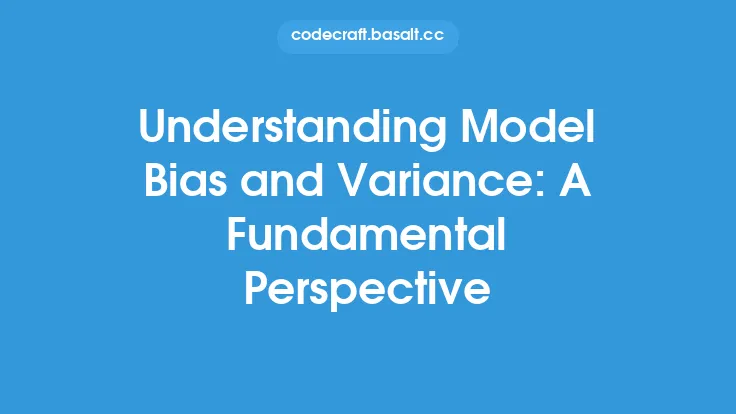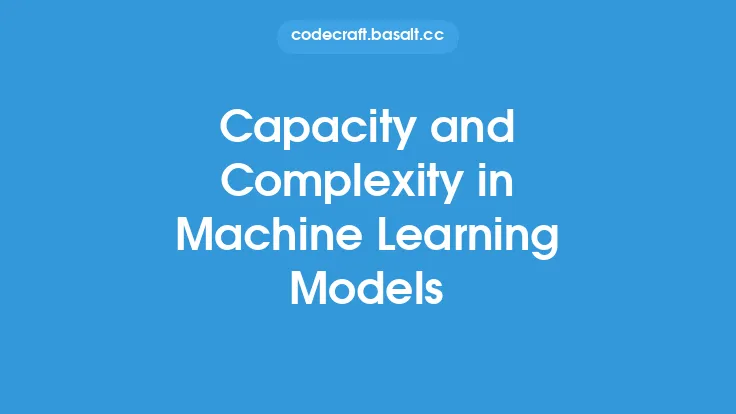Machine learning is a field of study that focuses on the use of algorithms and statistical models to enable machines to perform a specific task without using explicit instructions. The primary goal of machine learning is to develop models that can accurately predict outcomes or make decisions based on data. However, machine learning models can suffer from two major problems: overfitting and underfitting. These problems occur when a model is too complex or too simple, respectively, and can significantly impact the model's performance.
Introduction to Overfitting
Overfitting occurs when a model is too complex and learns the noise in the training data, rather than the underlying patterns. This results in a model that performs well on the training data but poorly on new, unseen data. Overfitting is a common problem in machine learning, especially when dealing with complex models and large datasets. There are several reasons why overfitting occurs, including the use of models with too many parameters, the presence of noise in the training data, and the use of models that are not regularized.
Introduction to Underfitting
Underfitting, on the other hand, occurs when a model is too simple and fails to capture the underlying patterns in the training data. This results in a model that performs poorly on both the training and testing data. Underfitting is often a result of using models that are too simple or have too few parameters. It can also occur when the training data is not representative of the problem being solved, or when the model is not trained for a sufficient amount of time.
The Difference Between Overfitting and Underfitting
The key difference between overfitting and underfitting is the complexity of the model. Overfitting occurs when a model is too complex, while underfitting occurs when a model is too simple. Overfitting results in a model that is too specialized to the training data, while underfitting results in a model that is too general and fails to capture the underlying patterns. Understanding the difference between overfitting and underfitting is crucial in developing effective machine learning models.
Causes of Overfitting and Underfitting
There are several causes of overfitting and underfitting. Overfitting can be caused by the use of models with too many parameters, the presence of noise in the training data, and the use of models that are not regularized. Underfitting, on the other hand, can be caused by the use of models that are too simple, the lack of representative training data, and insufficient training time. Additionally, overfitting and underfitting can be caused by the choice of algorithm, the quality of the data, and the hyperparameters used to train the model.
Consequences of Overfitting and Underfitting
The consequences of overfitting and underfitting can be significant. Overfitting can result in a model that performs poorly on new, unseen data, while underfitting can result in a model that fails to capture the underlying patterns in the data. Both overfitting and underfitting can lead to poor model performance, which can have significant consequences in real-world applications. For example, in medical diagnosis, a model that overfits or underfits can result in incorrect diagnoses, which can have serious consequences for patients.
Prevention and Detection of Overfitting and Underfitting
There are several techniques that can be used to prevent and detect overfitting and underfitting. These include the use of regularization techniques, such as L1 and L2 regularization, the use of cross-validation to evaluate model performance, and the use of techniques such as early stopping to prevent overfitting. Additionally, techniques such as feature selection and dimensionality reduction can be used to reduce the complexity of the model and prevent overfitting.
Real-World Applications
Overfitting and underfitting are not just theoretical concepts, but have significant implications in real-world applications. For example, in image recognition, a model that overfits can result in poor performance on new, unseen images, while a model that underfits can fail to recognize objects in images. In natural language processing, a model that overfits can result in poor performance on new, unseen text, while a model that underfits can fail to capture the nuances of language.
Conclusion
In conclusion, overfitting and underfitting are two major problems in machine learning that can significantly impact the performance of a model. Understanding the causes and consequences of overfitting and underfitting is crucial in developing effective machine learning models. By using techniques such as regularization, cross-validation, and early stopping, it is possible to prevent and detect overfitting and underfitting, and develop models that perform well on both the training and testing data. Additionally, understanding the difference between overfitting and underfitting, and the techniques used to prevent and detect them, can help developers to build more effective and robust machine learning models.





